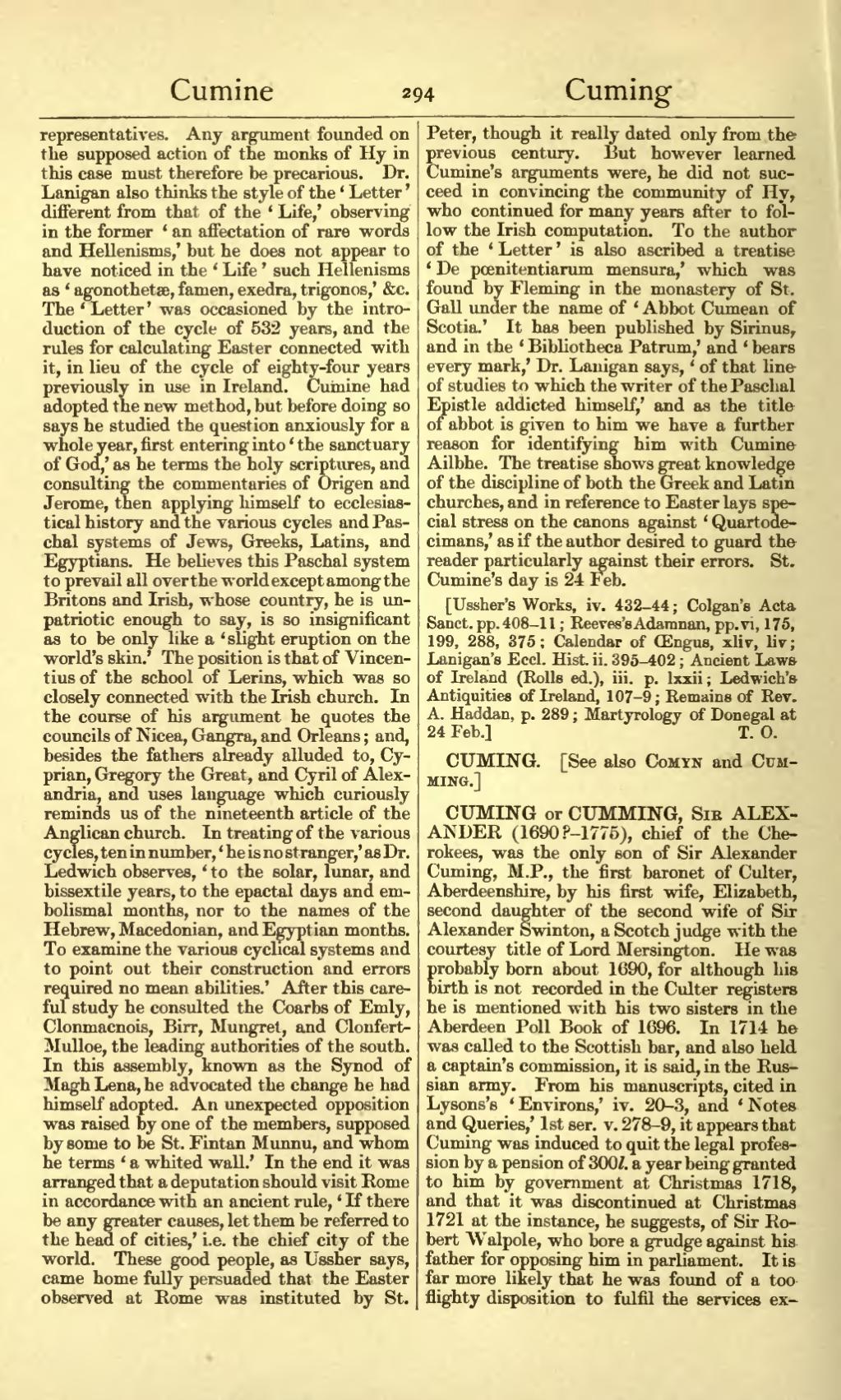representatives. Any argument founded on the supposed action of the monks of Hy in this case must therefore be precarious. Dr. Lanigan also thinks the style of the ‘Letter’ different from that of the ‘Life,’ observing in the former ‘an affectation of rare words and Hellenisms,’ but he does not appear to have noticed in the ‘Life’ such Hellenisms as ‘agonothetæ, famen, exedra, trigonos,’ &c. The ‘Letter’ was occasioned by the introduction of the cycle of 532 years, and the rules for calculating Easter connected with it, in lieu of the cycle of eighty-four years previously in use in Ireland. Cumine had adopted the new method, but before doing so says he studied the question anxiously for a whole year, first entering into ‘the sanctuary of God,’ as he terms the holy scriptures, and consulting the commentaries of Origen and Jerome, then applying himself to ecclesiastical history and the various cycles and Paschal systems of Jews, Greeks, Latins, and Egyptians. He believes this Paschal system to prevail all over the world except among the Britons and Irish, whose country, he is unpatriotic enough to say, is so insignificant as to be only like a ‘slight eruption on the world's skin.’ The position is that of Vincentius of the school of Lerins, which was so closely connected with the Irish church. In the course of his argument he quotes the councils of Nicea, Gangra, and Orleans; and, besides the fathers already alluded to, Cyprian, Gregory the Great, and Cyril of Alexandria, and uses language which curiously reminds us of the nineteenth article of the Anglican church. In treating of the various cycles, ten in number, ‘he is no stranger,’ as Dr. Ledwich observes, ‘to the solar, lunar, and bissextile years, to the epactal days and embolismal months, nor to the names of the Hebrew, Macedonian, and Egyptian months. To examine the various cyclical systems and to point out their construction and errors required no mean abilities.’ After this careful study he consulted the Coarbs of Emly, Clonmacnois, Birr, Mungret, and Clonfert-Mulloe, the leading authorities of the south. In this assembly, known as the Synod of Magh Lena, he advocated the change he had himself adopted. An unexpected opposition was raised by one of the members, supposed by some to be St. Fintan Munnu, and whom he terms ‘a whited wall.’ In the end it was arranged that a deputation should visit Rome in accordance with an ancient rule, ‘If there be any greater causes, let them be referred to the head of cities,’ i.e. the chief city of the world. These good people, as Ussher says, came home fully persuaded that the Easter observed at Rome was instituted by St. Peter, though it really dated only from the previous century. But however learned Cumine's arguments were, he did not succeed in convincing the community of Hy, who continued for many years after to follow the Irish computation. To the author of the ‘Letter’ is also ascribed a treatise ‘De pœnitentiarum mensura,’ which was found by Fleming in the monastery of St. Gall under the name of ‘Abbot Cumean of Scotia.’ It has been published by Sirinus, and in the ‘Bibliotheca Patrum,’ and ‘bears every mark,’ Dr. Lanigan says, ‘of that line of studies to which the writer of the Paschal Epistle addicted himself,’ and as the title of abbot is given to him we have a further reason for identifying him with Cumine Ailbhe. The treatise shows great knowledge of the discipline of both the Greek and Latin churches, and in reference to Easter lays special stress on the canons against ‘Quartodecimans,’ as if the author desired to guard the reader particularly against their errors. St. Cumine's day is 24 Feb.
[Ussher's Works, iv. 432–44; Colgan's Acta Sanct. pp. 408–11; Reeves's Adamnan, pp. vi, 175, 199, 288, 375; Calendar of Œngus, xliv, liv; Lanigan's Eccl. Hist. ii. 395–402; Ancient Laws of Ireland (Rolls ed.), iii. p. lxxii; Ledwich's Antiquities of Ireland, 107–9; Remains of Rev. A. Haddan, p. 289; Martyrology of Donegal at 24 Feb.]
CUMING. [See also Comyn and Cumming.]
CUMING or CUMMING, Sir ALEXANDER (1690?–1775), chief of the Cherokees, was the only son of Sir Alexander Cuming, M.P., the first baronet of Culter, Aberdeenshire, by his first wife, Elizabeth, second daughter of the second wife of Sir Alexander Swinton, a Scotch judge with the courtesy title of Lord Mersington. He was probably born about 1690, for although his birth is not recorded in the Culter registers he is mentioned with his two sisters in the Aberdeen Poll Book of 1696. In 1714 he was called to the Scottish bar, and also held a captain's commission, it is said, in the Russian army. From his manuscripts, cited in Lysons's ‘Environs,’ iv. 20–3, and ‘Notes and Queries,’ 1st ser. v. 278–9, it appears that Cuming was induced to quit the legal profession by a pension of 300l. a year being granted to him by government at Christmas 1718, and that it was discontinued at Christmas 1721 at the instance, he suggests, of Sir Robert Walpole, who bore a grudge against his father for opposing him in parliament. It is far more likely that he was found of a too flighty disposition to fulfil the services ex-

